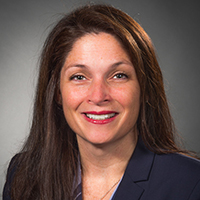Health systems have found ways to overcome challenges, embrace opportunities during the COVID-19 pandemic, leaders say
- Three health systems have managed to overcome much of the financial setbacks brought on by COVID-19, their finance leaders said during HFMA’s Digital Annual Conference.
- One system has reaped the benefits of its parent organization’s decision to avoid furloughing staff.
- Another system is looking to use the momentum of its response to the pandemic by continuing its transition into a population health company.
Striving to be nimble, proactive and innovative in their responses to the COVID-19 pandemic, health systems have relied on the strength of their organizational cultures.
That was a central takeaway Wednesday from the featured general session of Day 3 of HFMA’s Digital Annual Conference. In “Navigating Through a Pandemic: Resilience and Rebuilding,” a panel of health system leaders discussed the challenges and opportunities of the current environment.
“We’re talking probably a period of three weeks in which the whole world transformed around them,” said Michele Cusack, senior vice president and CFO of Northwell Health, referring to staff in departments such as revenue cycle and supply chain. “And they responded.”
Dealing with the first wave of cases
For each panelist, the pandemic drove home the importance of retaining the capacity to implement rapid changes to operations.
Northwell Health, based in New York City, was at the epicenter of the largest volume of cases in the pandemic’s early wave. The organization benefited from having installed an emergency management infrastructure about a decade earlier to prepare for natural disasters and other emergencies. The infrastructure allowed Northwell Health to coordinate across departments in preparation for the influx of cases, Cusack said.
“We were able to quickly change and adapt the clinical protocols across the system and get that information updated quickly through the back-end IT systems in ways that we really haven’t had to do in the past,” she said.

Michele Cusack, Northwell Health
Adjusting to the financial crunch
At Bellin Health in Green Bay, Wisconsin, revenues fell by more than 50% when elective procedures came to a halt from mid-March through April, said Jim Dietsche, CPA, the health system’s CFO and COO. The organization’s operating margin for April was minus-20%. By June, however, revenues exceeded pre-COVID-19 forecasts for the month.
St. John Health System in Tulsa, Oklahoma, was 8% off budget through May, a drop of about 6 percentage points since the start of the pandemic. But after elective-surgery volume dropped to 39% year-over-year in April, it rebounded to 96% in June. “There was a lot of communication with our medical staff and others in the community to present that we are taking the necessary precautions to have a safe place to [get] healthcare,” said Ann Paul, DrPH, chief strategy officer.
Northwell Health estimates the full-year impact of COVID-19 will be slightly under $2 billion, Cusack said, including $1.5 billion through June. Volumes are rebounding, although emergency department (ED) volumes are at only 70% of pre-pandemic levels. The drop-off is significant given the ED’s role as a driver of admissions.

Ann Paul, St. John Health System
Finding ways to keep operations humming
Ascension, the parent organization of St. John Health System, made a national commitment to avoid furloughing staff despite the drop in volume.
“Part of the strategy in having the assurance regarding the workforce was to make sure that we were focused on driving the safety for our patients and associates and physicians,” Paul said. “That’s not a cost reduction activity on the surface, but it has made it a lot easier for us to reengage and get more of the volumes back.”
Recognizing the need to maintain as steady a cash flow as possible, Bellin Health’s leadership focused on supporting revenue cycle operations. “It was simply amazing for me because one day they’re working in the office and the next day they’re working from home — and coding and documentation and the billing processes and follow-up work really just continued to flow because of, I would say, a can-do attitude,” Dietsche said.

Jim Dietsche, Bellin Health
Getting back to ‘normal’
Having come out of the first wave of the pandemic, Northwell Health is seeking to be nimbler in its operations going forward. The organization wants to leverage the emergency infrastructure it had set up before the pandemic.
“Once we were given the go-ahead by the state to be able to resume normal activity, we had almost a playbook fully in hand to execute on that,” Cusack said.
“The biggest focus was on the surgical side to get those procedures in, based on the risks posed to the patients in terms of the delays that they were facing. So it was a coordinated effort across the system. It wasn’t by an individual market or an individual hospital.”
Ramping up the transition to value
Northwell Health sees an opportunity in direct-to-employer arrangements coming out of the pandemic, including in its on-site clinics, Cusack said.
“There are certain large players in the area, and given their concerns on the health of their employees coming back to the workplace and other things, we see an opportunity to kind of get in there before the insurance company and do things slightly differently,” she said. “Just working differently with them and showing them that we’re more than just a fee-for-service type of player, that we’re there for the health of their employees.”
In addition to her role at St. John, Paul is chair of the Tulsa City-County Board of Health. The department launched a work group to examine how best to promote community-based COVID-19 testing. The group’s focus soon expanded to the impact of the disease on the poor and vulnerable, including the homeless population.
“I do expect when we talk about innovation going into the future, we’re going to see a lot more telemedicine and other types of modes of care being made available to this population in our community,” Paul said.
Considering opportunities for strategic transformation
Health systems are using the pandemic as an opportunity to assess potential changes to their care delivery and business models.
Bellin Health is seeking to repurpose assets to place more of an emphasis on telehealth and ambulatory care, Dietsche said. Such moves are part of the health system’s ongoing push to transform from a healthcare delivery system to a population health company.
“The communication processes and the engagement with our providers have just evolved tremendously through this,” he said. “There’s a lot of momentum to manage patients differently. I think when providers saw their volumes change dramatically and they had to interface with their patients in a much different way, that gives us an opportunity that we just didn’t have before.”





